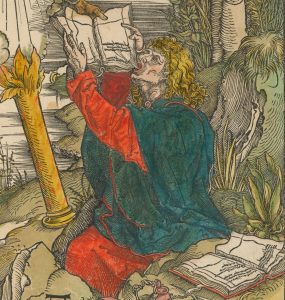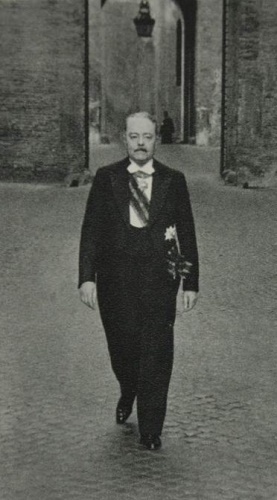|
|
Where and when the phrase “You’ll eat those words,” the standard idiom to suggest something said or written will be retracted, originated is unknown. As far back as the Book of Revelation, John of Patmos must eat a book held by an angel. A book of proverbs printed at Cambridge University in 1670 contained the phrase, “to eat ones [sic] words,” the idiom’s first appearance in print. History might suggest that’s because someone with enough power in the 17th century could turn the phrase into a command.
Take the case of Austrian politician Isaac Volmar, a longtime adviser to the Habsburg Empire. He played a prominent role in defense of Breisbach, a fortress on the Rhine River, in 1638. The garrison fell to French forces commanded by Bernhard of Saxe-Weimar after a four-month siege. At some point, Volmar wrote that Bernhard was a beggar prince. Volmar was among those repatriated but not before Bernhard forced him to eat what he’d written.
Six years later, Danish author Theodore Reinking was disturbed by his country’s diminished political and military power. He wrote a book blaming the decline on “the treachery of the Swedes.” Reinking was arrested and thrown into prison. Worse for him, under Swedish law, anyone who wrote a foolish or evil book was condemned to eat it under penalty of death, according to an article by U.M. Rose in the American Law Review in 1897. Reinking opted for the epicurean route. “It is said that he cooked his book up into some kind of a sauce, in which form it no doubt acquired a piquancy that it had not before possessed,” said Rose, a founder of the American Bar Association.
 St. John eating the angel’s book Both Volmar and Reinking had it better than Phillipp Oldenburger, a German legal scholar. His 1669 book describing intimate details from life at German royal courts was salacious enough to be confiscated in several German principalities. One young prince was so upset by satirical remarks about his love life that Oldenburger had to eat the two most libelous pages of the book. While the quantity was small, that order required flogging him while doing so, a flogging that wouldn’t stop until he had swallowed the last crumb, according to the March 31, 1906, edition of Scientific American.
The 17th century wasn’t unique. A noted case of “eat those words” happened some 300 years before and involved Pope Urban V.
Bernabò Visconti, the Duke of Milan from 1354 to 1385, tended to wage war to capture parts of the Holy See. He had the distinction of being excommunicated by three different popes. Sources differ when the excommunication giving rise to the most common story about Pope Urban’s involvement occurred.
An abbot at the time, Pope Urban and a cardinal were sent to Milan to deliver a bull of excommunication to Visconti. He either took them to or met them at the middle of a bridge over a large canal in central Milan. There he told them, “Don’t think you can go before having either eaten or drunk in such a way that you will remember me,” according to Alice Curtayne’s Saint Catherine of Siena. She reports,
The legates looked at the murky river beneath them and one of them answered, with an attempt at lightness: “I prefer to eat than to ask to drink near such a river.” “Very well,” replied Bernabò, “here are your bulls of excommunication. You shall not leave this bridge before you have eaten in my presence the parchment on which they are written, the leaden seals hanging from them and the silk cords which attach them.” In the midst of the armed guards and a huge crowd of people, the legates were forced to obey.
Immediately after he was elected pope in 1372, Urban excommunicated Visconti. Some reports say it was this bull of excommunication Visconti ordered consumed when delivered in 1373. At least one says that, instead of meeting on the bridge, the legates were arrested and imprisoned until they ate the parchment, lead seal, and silk cord. Regardless, there seems agreement that Visconti ordered two papal legates to eat a pope’s words.
The 21st century, of course, is more user-friendly — or over the top. In 2012, Land Rover created a guide for customers in the United Arab Emirates on surviving in the Arabian Desert. The company wrapped the 28-page book in reflective packaging, which could signal for help, and bound it with a metal spiral useable for cooking. Land Rover took an extra step. It printed the book in edible ink so that in an emergency, “people could always EAT the book,” according to a Land Rover advertisement. The company claimed the book “had a nutritional value close to that of a cheeseburger.”
In the course of my life I have often had to eat my words, and I must confess that I have always found it a wholesome diet.
Winston Churchill, quoted in William Manchester,
The Last Lion: Winston Spencer Churchill, Vol. 2
(Originally posted at History of Yesterday)
Interesting Reading in the Interweb Tubez
Blog Headline of the Week
Nonbookish Linkage
Bookish Linkage
History teaches us that men and nations behave wisely once they have exhausted all other alternatives.
Abba Eban, December 16, 1970
More than 60 years after his death, debate still surrounds the action or inaction of Pope Pius XII during the Holocaust. Echoes of controversy that arose upon his death have receded, though. That’s the uproar caused by the actions of the pope’s personal physician.
Born Eugenio Pacelli in Rome in 1876, Pius XII held several Vatican diplomatic positions before becoming pope in March 1939. While serving as the Holy See’s Secretary of State in the 1930s, Pacelli suffered eye-related problems. Dr. Riccardo Galeazzi-Lisi, a Rome ophthalmologist, solved them. Even though the doctor had limited training as an internist, the newly elected pope asked him to treat injuries from a slip and fall. Pius XII then named him Archiatra Pontificio, a pontiff’s personal physician. with limited training as an internist
Galeazzi-Lisi methods raised eyebrows. For example, in the summer of 1952, the pope was stricken with gastritis. Galeazzi-Lisi’s diagnosed “chromic acid poisoning” caused by the pope’s toothpaste, according to John-Peter Pham, an American priest who served in the Vatican diplomatic service. He didn’t mention that he recommended the dentist who prescribed chromic acid, a chemical used in tanning hides. When gastritis recurred the next year, Galeazzi-Lisi called in a Swiss doctor to treat the pope with injections of cell extracts from lamb fetuses, according to Pham. Pius XII received more such treatments in 1954 when gravely ill with gastritis and a hernia of the diaphragm.
Galeazzi-Lisi’s unconventional behavior wasn’t limited to medical matters. In the early 1950s, he sold photos of the pope doing push-ups. Ultimately, the publications decided not to publish the pictures. During the pope’s 1954 illness, which brought him near death, the doctor offered to sell accounts of the pope’s life and illness for $12,000. There were no takers.
 Dr. Riccardo Galeazzi-Lisi Galeazzi-Lisi’s real opportunity came in October 1958, when Pius XII was dying at Castel Gandolfo, the papal summer residence just south of Rome. He agreed to inform an Italian news agency of the pope’s death before any official announcement, according to Pham. Galeazzi-Lisi would open a particular window at Castel Gandolfo to signal that the pope was dead. Someone else, though, cracked the window open to let in some air. As a result, three Italian newspapers ran special editions reporting Pius XII’s death a day before he died.
During the pope’s last days, Galeazzi-Lisi made detailed clinical notes and took pictures of Pius XII in his death throes. Within a week of the pope’s death, Galeazzi-Lisi solicited bids for that material. According to TIME magazine, he wanted $13,320 for a story on his life with the pope, including the clinical details of the pope’s last days; $8,000 for an hour-by-hour account of the pope’s demise; and, $3,200 for the photographs. Two Italian daily newspapers jointly bought the second item for $3,200. Only one printed it, after deleting “certain passages which appeared to us too crude,” TIME reported.
To make matters worse, Galeazzi-Lisi said the pope wanted him to embalm the body. He didn’t follow standard procedures. Instead, Galeazzi-Lisi used a method he claimed was much like that used on Jesus Christ and would allow the body to last indefinitely without decaying. He called the process “aromatic osmosis,” the New York Times reported. Pius XII’s body was enclosed in a cellophane bag after being sprinkled with oils, resins, and deoxidizing chemicals.
The result was a disaster. Placing the wrapped body in a closed casket prevented bodily chemicals and gases from escaping, hastening decomposition, particularly in the autumnal heat. The consequences were soon apparent. During the procession taking the body to Rome, there was a loud “pop” or “bang.” Some said the buildup of gases caused the seals of the casket to rupture. More commonly reported is that the pope’s chest cavity burst open.
By the time Pius XII arrived at St. Peter’s Basilica, his body had turned green and the smell of decay was evident. Embalming experts worked on the body during the night but were unable to slow the decay. Artists applied grease paint and other compounds to make the body presentable. The body was placed on a six-foot-high catafalque so mourners couldn’t see the facial discolorations up close.
Galeazzi-Lisi applied more of the substances he used but without the cellophane. As a result, the New York Times reported, the eyes of those standing vigil “smarted and watered.” Other reports said the four Swiss guards standing watch over the pope’s bier were changed every 15 minutes because of the stench. At some point, the pope’s nose turned black and fell off.
On October 18, 1958, five days after the pope’s funeral, the Vatican publicly reprimanded Galeazzi-Lisi for disclosing information about the pontiff’s final days. The embalming wasn’t mentioned. The New York Times report, though, noted that “many hundreds of thousands” saw its results when viewing the body as it laid in state.
Two days later, following a meeting of the College of Cardinals, Galeazzi-Lisi resigned as head of the Vatican’s medical department. The College, which would soon sit to elect a new pope, ordered Vatican City police authorities to bar Galeazzi-Lisi from entering the 108-acre pontifical state. The Italian Medical Council expelled him for ethical violations, but a court later ordered his reinstatement on procedural grounds. In December 1958, the Rome Medical Association barred him from practice for violating professional ethics in selling information about the pope.
Galeazzi-Lisi, who died in 1968, insisted he’d done nothing wrong. He said he breached no medical confidences because the “medical profession secret ends with the death of the patient.” Instead, any criticism resulted from the “envy” of other physicians. In 1960, he set out his version of events in a book, Dans l’Ombre et la Lumière de Pie XII (“In the Shadow and the Light of Pius XII”). The book used photos of Pius XII on his deathbed and during the embalming.
Ultimately, what may be the most puzzling question was raised by a Milan newspaper. “How could Pius XII entrust his health for so many years to a quack?”
Have you seen a photo of Pius XII? In a James Bond movie, he’d have been the head of SPECTRE.
Umberto Eco, Numero Zero
(Originally posted at History of Yesterday)
Interesting Reading in the Interweb Tubez
- How the Pandemic Now Ends (“Vaccines remain the best way for individuals to protect themselves, but societies cannot treat vaccines as their only defense.”)
Nonbookish Linkage
Bookish Linkage
- Brits organize their bookshelves randomly
The world is a hell because we have made it so.
Brian Evenson, “Nameless Citizen,”
The Glassy, Burning Floor of Hell
For years, this blog’s had a page for what I call my Desert Island Books. It’s a take-off on BBC radio’s “Desert Island Discs,” where guests pick the eight recordings they’d want with them if stranded on a desert island.
I’m well aware of how opinions of books can vary. You know, one person’s treasure is another person’s trash. Out of curiosity, I decided to take a look at the one-star Amazon reviews for my Desert Island Books. I decided to post a few that are mind-boggling, irrational, inane, or intentionally or unintentionally humorous. I’m not linking the reviews or others, merely identifying them by country and date. All punctuation and spellings are verbatim.
Other similar posts may follow, including reviews of other notable books.
 1984, George Orwell 1984, George Orwell
- I don’t like this book! We should put God’s first and honor Him. I felt so empty it caused me to Dry spiritual! I don’t recommend it! It is so sad that college recommended to read it. That’s not good for our blessing spiritual who are truly faithful in the Lord (truly Christ/Messiah) [US, April 28, 2021] (BTW, two people found this review “helpful.”)
- I can not describe in words how much of a waste of time it was reading this book. I waited and waited for it to get better but there is simply nothing redeemable about this book. Orwell rambles on in a depressing way for hundreds of pages. Often he repeats paragraphs in a slightly different and more depressing way. If someone recommends this book to you, they are not your friend or they need clinical help. I’m basically just really sad now. The sooner I forget about this thing the better I’ll feel. [US, Sept. 21, 1918]
- It wasn’t what I expected the book was great but the film was rubbish. Personally I think they should reshoot the film and bring it up to date then it will be brilliant. [U.K., Feb. 2, 2021] (Excuse me, your review is supposed to be about the book, not a movie.)
- Really not sure what all the fuss is about? Maybe heavy drugs are required to make sense of it? [Australia, April 4, 2020]
 The Things They Carried, Tim O’Brien The Things They Carried, Tim O’Brien
- After reading the first few chapters I closed the book and will not read any more of it. In just the first few chapters they killed a puppy with a claymore and tortured a baby water buffalo. I wa[s] in the war but the senseless killing of animals is where I draw the line. [US, April 9, 2019] (As the next review indicates, this isn’t the only person more offended by the deaths of animals than the deaths of humans.)
- The puppy died quickly, so did fellow squad member [name omitted to avoid spoiler], but not that tortured baby buffalo. I could not read past that. [US, June 19, 2020]
- Horrible book. It’s just a bunch of swearing and mushy stuff that nobody cares about. It is trying to be cool the entire time, it adds in all of this symbolism and junk for the sole purpose of making English teachers like it. [US, June 20, 2020] (Let me guess, the book was assigned for a class.)
- To be honest, after seeing that this book was such a big deal in the literary community, I was not surprised to find out that it sucked. I could write better than this. There is no plot at all…it is just some pretentious sobbing guy rambling on and on about nothing in particular. [US, Jan. 5, 2011]
 The Sparrow, Mary Doria Russell (4.4/5 stars) The Sparrow, Mary Doria Russell (4.4/5 stars)
- Uhhhh…. another shockingly bad book. I got 20% in before spitting on my Kindle and throwing it at my dog. [Sept. 5, 2012]
- I thought The Sparrow was without any question the vilest piece of trash I have encountered between two covers in more than 50 years of reading novels. …. Complaining that the author uses inept science fiction as a vehicle expound a rabidly Catholic belief system strikes me as the understatement of the decade. [US, Dec. 24, 2013]
- This book was a hot mess. It was like a pathetic version of characters from Gilligan’s Island. [US, July 21, 2019]
- I do not like unhappy endings, and this book had one of the worsts ending in a book that I have read in a long time. [US, Sept. 21, 2014]
Asking a working writer what he thinks about critics is like asking a lamppost what it feels about dogs.
Christopher Hampton, Sunday Times Magazine (Oct. 16, 1977)
|
Disclaimer 
Additionally, some links on this blog go to Amazon.com. As an Amazon Associate I earn from qualifying purchases. There is no additional cost to you. Contact me You can e-mail me at prairieprogressive at gmaildotcom.
|












